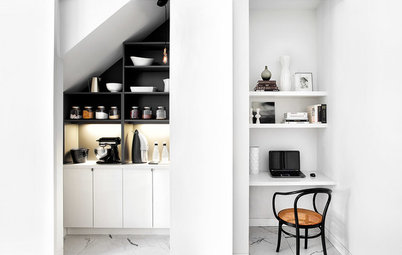Renovating
How to Read Your Architect's Plans
Understanding complex floor plans comes easy once you break it down into its basic components
Reading plans may come naturally to some, but for others who don’t have a sense of space or can’t visualise a plan in 3D, it can be a little overwhelming – there is a lot to take in. To move forward with your designer or architect’s preliminary plans, you need to have a firm understanding of what you’re looking at. Otherwise, you may end up with a renovation that looks nothing like you had imagined. Let’s look at a floor plan and its elements in detail.
Doors, windows and stairs are highlighted on the plan in yellow
These important items are shown in their intended location and their exact size is indicated in the dimension notation.
DOORS: Doors are indicated in a plan with a line perpendicular to the wall and with a quarter circle, which shows the swing of the door. The perpendicular line is the side the door is hinged on.
WINDOWS: Windows are shown, of course, within the walls on the plan and are indicated typically by three parallel lines. When looking at windows and doors, you should also refer to the elevations of that particular wall, as a plan does not indicate the height or type of each door and window.
With windows, it is important to know the overall height and sill height position. You may think you have an unwanted large window within a functioning living space when looking at it on a plan, when in fact the designer has allowed for a much smaller highlight window.
There will be a window and door schedule to accompany your plans and elevations, which you must also go over to fully understand the size, shape and function of each.
STAIRS: Stairs take up a fair amount of floor space. They are typically shown as parallel lines with an arrow indicating up. Stairs have to meet building code standards with minimums and maximums when it comes to the stair tread (step) and riser height.
These important items are shown in their intended location and their exact size is indicated in the dimension notation.
DOORS: Doors are indicated in a plan with a line perpendicular to the wall and with a quarter circle, which shows the swing of the door. The perpendicular line is the side the door is hinged on.
WINDOWS: Windows are shown, of course, within the walls on the plan and are indicated typically by three parallel lines. When looking at windows and doors, you should also refer to the elevations of that particular wall, as a plan does not indicate the height or type of each door and window.
With windows, it is important to know the overall height and sill height position. You may think you have an unwanted large window within a functioning living space when looking at it on a plan, when in fact the designer has allowed for a much smaller highlight window.
There will be a window and door schedule to accompany your plans and elevations, which you must also go over to fully understand the size, shape and function of each.
STAIRS: Stairs take up a fair amount of floor space. They are typically shown as parallel lines with an arrow indicating up. Stairs have to meet building code standards with minimums and maximums when it comes to the stair tread (step) and riser height.
The above image is an elevation of a kitchen, showing all dimensions and finishes
Once you have worked out what the size of each space is in the floor plan and have worked out where the doors, windows and any other openings are, you can then look at the plan with the elevations. Doing this may assist you in gaining a sense of the intended three-dimensional space that will be built.
Elevations are basically a view of each vertical wall from floor to ceiling; elevations are also drawn in two dimensions and show any penetrations in them, such as the doors and windows. Elevations also show the heights of fixtures and fittings, such as joinery. To work out what elevation goes with which wall, a floor plan will have a reference or symbol that lets you know which elevation to look at. The same dimension style that the plan shows will be used on the elevations and these dimensions will indicate certain heights and widths of items.
Once you have worked out what the size of each space is in the floor plan and have worked out where the doors, windows and any other openings are, you can then look at the plan with the elevations. Doing this may assist you in gaining a sense of the intended three-dimensional space that will be built.
Elevations are basically a view of each vertical wall from floor to ceiling; elevations are also drawn in two dimensions and show any penetrations in them, such as the doors and windows. Elevations also show the heights of fixtures and fittings, such as joinery. To work out what elevation goes with which wall, a floor plan will have a reference or symbol that lets you know which elevation to look at. The same dimension style that the plan shows will be used on the elevations and these dimensions will indicate certain heights and widths of items.
If you manage to get through all the plans, elevations and details of the preliminary drawings and still struggle with visualising the space, it is quite common these days for 3D views to be produced of the space. Ask your architect or designer if this is possible.
TIP: The best way to work out if each functioning space shown in a floor plan is large enough for its intended use is to get a tape measure out and plot a space on the floor in front of you. If the space doesn’t seem big enough then let the architect or designer know as soon as possible because the space will have to be taken from elsewhere to meet your needs.
YOUR SAY
Have you had a renovation go wrong? Share your tales of woe in the Comments.
MORE
From the Pros: How to Work With an Architect
How to Find the Right Architect for You
From the Pros: 8 Design Habits of a Successful Architect
17 Ways to Get Into Your Architect’s Brain
TIP: The best way to work out if each functioning space shown in a floor plan is large enough for its intended use is to get a tape measure out and plot a space on the floor in front of you. If the space doesn’t seem big enough then let the architect or designer know as soon as possible because the space will have to be taken from elsewhere to meet your needs.
YOUR SAY
Have you had a renovation go wrong? Share your tales of woe in the Comments.
MORE
From the Pros: How to Work With an Architect
How to Find the Right Architect for You
From the Pros: 8 Design Habits of a Successful Architect
17 Ways to Get Into Your Architect’s Brain

















By definition, a floor plan is a drawing to scale, showing a view from above of the relationships between rooms, spaces and other physical features at one level of a structure. It is a two- dimensional drawing that shows spaces with labels so we know what their function is.
What is typically shown on a floor plan?
The plan is essentially the most detailed and important drawing to understand. A floor plan shows the layout of a home; it is a bird’s-eye view of the space. It also shows how each space flows from one to the other.
On a floor plan, walls, doors, windows, any stairs, fittings and fixtures, and dimensions are shown. All plans are drawn at a certain scale, such as 1:100, 1:50, or 1:20 (metrics will vary). The scale of the plan is usually shown directly under the plan drawing and in a legend on the side of the drawing. The legend will also note the client’s name and address, the title of the drawing and the name and details of the person or company that created the drawings.